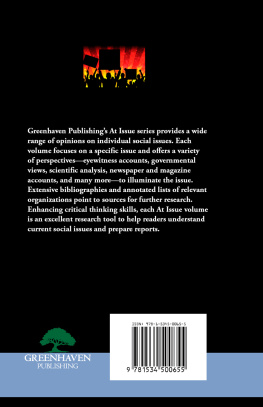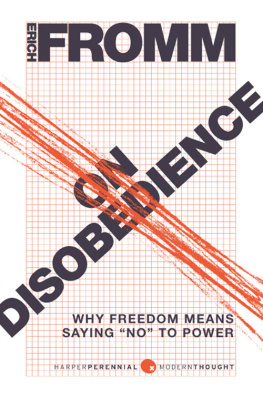Intelligent Disobedience
Doing Right When What
Youre Told to Do Is Wrong
Intelligent Disobedience
Doing Right When What
Youre Told to Do Is Wrong
Ira Chaleff

Intelligent Disobedience
Copyright 2015 by Ira Chaleff
All rights reserved. No part of this publication may be reproduced, distributed, or transmitted in any form or by any means, including photocopying, recording, or other electronic or mechanical methods, without the prior written permission of the publisher, except in the case of brief quotations embodied in critical reviews and certain other noncommercial uses permitted by copyright law. For permission requests, write to the publisher, addressed Attention: Permissions Coordinator, at the address below.

Berrett-Koehler Publishers, Inc.
1333 Broadway, Suite 1000
Oakland, CA 94612-1921
Tel: (510) 817-2277, Fax: (510) 817-2278
www.bkconnection.com
Ordering information for print editions
Quantity sales. Special discounts are available on quantity purchases by corporations, associations, and others. For details, contact the Special Sales Department at the Berrett-Koehler address above.
Individual sales. Berrett-Koehler publications are available through most bookstores. They can also be ordered directly from Berrett-Koehler: Tel: (800) 929-2929; Fax: (802) 864-7626; www.bkconnection.com
Orders for college textbook/course adoption use. Please contact Berrett-Koehler: Tel: (800) 929-2929; Fax: (802) 864-7626.
Orders by U.S. trade bookstores and wholesalers. Please contact Ingram Publisher Services, Tel: (800) 509-4887; Fax: (800) 838-1149; E-mail: for details about electronic ordering.
Berrett-Koehler and the BK logo are registered trademarks of Berrett-Koehler Publishers, Inc.
First Edition
Paperback print edition ISBN 978-1-62656-427-5
PDF e-book ISBN 978-1-62656-428-2
IDPF e-book ISBN 978-1-62656-429-9
2015-1
Interior design and project management: Dovetail Publishing Services Cover design: Brad Foltz
To the young and the not so young who make decisions to obey or not to obey, conscious of their personal responsibility for the outcome regardless of which decision they make, no matter who gave the order.
Contents
PREFACE
How I Learned About Intelligent Disobedience
WHAT EXACTLY IS INTELLIGENT DISOBEDIENCE? I had the same question when I first heard the term. These are two words that dont usually fit together.
We know what obedience is: following orders or rules or established ways of doing things. Obeying usually keeps life running smoothly. Disobedience is a contrary response to these common obligations of life. Disobeying often results in unpleasant consequences. Those issuing the orders or setting the rules are inclined to enforce them, and they usually have the power to do so. Therefore, its reasonable to ask, under what circumstances can disobedience be considered intelligent?
I suspect you would agree that those with the authority to issue orders or to establish rules are not infallible. Youve experienced that reality, perhaps more often than youd like. In some circumstances, the information on which authorities are basing a specific order or rule may be incomplete, old, or plain wrong. Their intentions may be excellent, but their assessment of the situation and their judgment may be faulty. Or the order may be ethically problematic. In these circumstances, implementing that order or rule would probably lead to an undesirable outcome, perhaps even a dangerous one. It would be better to question the order rather than obey it. That would be Intelligent Disobedience.
This seems like common sense, yet it can be a difficult thing to do. People like to believe they would have the courage to resist an order that would cause harm. Contrary to this belief, research and history show us that in many situations the majority will obey. Depending on the circumstances, perhaps you would obey.
The purpose of this book is to help individuals at all stages of human development, and in all types of work, achieve the awareness and skills to avoid the just following orders trap. Regardless of the pressure we feel to obey those in authority, we are accountable for our actions. We need to be able to take a stand and do the right thing when what we are told to do is wrong. If we do this well, even those issuing the wrong orders will benefit from our having made the right choice.
I first heard the term Intelligent Disobedience when I was teaching a class on leader-follower relationships to a group of mid-level managers. We were at the point in the class where I introduce the question When is it appropriate to obey authority and when should authority be questioned? This is a central question for all of us who live in complex societies and who work or study in hierarchies in which other people have the authority to give us directions.
A woman seated to my left raised her hand and said,
I have an example of this under the table.
The whole class joined me in a moment of collectively being startled by her statement. What did she mean, under the table?
Her classmates had stopped paying attention to the unusual act of bringing a dog to class every morning. She was low key about it and the dog rested quietly, almost invisibly, at her feet. I taught only one day of the students two-week course. In my focus on making sure the room and equipment were properly set up, I had failed to register this student was accompanied by a dog. So much for my powers of observation!
She went on to explain,
I am helping to train a guide dog that will assist an individual who is blind. At my stage of training, the dog is learning to be comfortable in busy social situations and to obey all the basiccommands she will be given when working as a guide dog. When I finish this part of her program, she will go to a more skilled trainer who will teach her Intelligent Disobedience.
My ears perked up more or less like a dog that has just heard something that grabs its attention!
What do you mean by Intelligent Disobedience? I asked, intuitively attracted to this term I had never heard before.
Most of the time, she continued, its really important that the dog obeys the humans instructions. But sometimes it would be dangerous to do so; for example, when a man with limited sight gave the command to step off a curb just as a quiet hybrid car was turning into the street. The dog must know not to obey a command that will put the teamhuman and dogin danger. Learning not to obey is a higher order of skill. It will require a trainer who is more experienced than I am.
Here was an example right under my nose of what I had been thinking and writing about for fifteen years! It is part of the socialization process in any human culture to teach our young to obey. Some cultures do it in harsh, authoritarian ways, and others do so more gently. However it is accomplished, children must be responsive to formal authority as they grow into adulthood. As adults, they must be responsive to the formal authorities in their organizations chains of command.
If the kindergarten teacher asks everyone to rest quietly for fifteen minutes, the students must do so and not pester the kids next to them whose eyes are closed. If the football coach says no partying the night before the game, a player must resist temptation from peer pressure to party or face being sidelined. The examples are endless of how we teach and reinforce the obedience that the culture requires.
Next page










